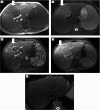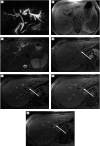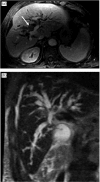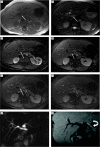Magnetic Resonance Imaging of cholangiocarcinoma
- PMID: 18250017
- PMCID: PMC1434592
- DOI: 10.1102/1470-7330.2004.0018
Magnetic Resonance Imaging of cholangiocarcinoma
Abstract
Preoperative imaging with MRI/MRA/MRCP is an accurate non-invasive method for staging cholangiocarcinoma,and determining resectability. It provides information regarding tumor size, extent of bile duct involvement, vascular patency, extrahepatic extension, nodal or distant metastases, and the presence of lobar atrophy. MRCP is better for demonstrating bile ducts distal to the stricture, although with ERCP, therapeutic intervention such as stent placement and biopsy can be performed.
Figures





Similar articles
-
Differentiation of extrahepatic bile duct cholangiocarcinoma from benign stricture: findings at MRCP versus ERCP.Radiology. 2004 Oct;233(1):234-40. doi: 10.1148/radiol.2331031446. Epub 2004 Aug 27. Radiology. 2004. PMID: 15333766
-
Selective MRCP and CT-targeted drainage of malignant hilar biliary obstruction with self-expanding metallic stents.Gastrointest Endosc. 2003 Jul;58(1):41-9. doi: 10.1067/mge.2003.292. Gastrointest Endosc. 2003. PMID: 12838219
-
Malignant obstructive jaundice: comparison of MRCP and ERCP in the evaluation of distal lesions.Radiol Med. 2003 May-Jun;105(5-6):445-53. Radiol Med. 2003. PMID: 12949455 English, Italian.
-
Hilar cholangiocarcinoma: MRI/MRCP in staging and treatment planning.Abdom Imaging. 2008 Jul-Aug;33(4):444-51. doi: 10.1007/s00261-007-9281-6. Abdom Imaging. 2008. PMID: 17638040 Review.
-
Staging of extrahepatic cholangiocarcinoma.Eur Radiol. 2008 Oct;18(10):2182-95. doi: 10.1007/s00330-008-1006-x. Epub 2008 May 6. Eur Radiol. 2008. PMID: 18458911 Review.
Cited by
-
A Cholangioblastic Variant of Cholangiocarcinoma.ACG Case Rep J. 2022 Feb 15;9(2):e00746. doi: 10.14309/crj.0000000000000746. eCollection 2022 Feb. ACG Case Rep J. 2022. PMID: 35187186 Free PMC article.
-
Gadoxetic acid magnetic-enhanced resonance imaging in the diagnosis of cholangiocarcinoma.World J Gastroenterol. 2020 Aug 7;26(29):4261-4271. doi: 10.3748/wjg.v26.i29.4261. World J Gastroenterol. 2020. PMID: 32848332 Free PMC article. Review.
-
Comparative diagnostic performance of [68 Ga]Ga-FAPI PET/CT and [18 F]FDGPET/CT in biliary tract cancers: a systematic review and meta-analysis.Eur J Nucl Med Mol Imaging. 2025 Sep;52(11):4200-4212. doi: 10.1007/s00259-025-07264-5. Epub 2025 Apr 11. Eur J Nucl Med Mol Imaging. 2025. PMID: 40214739 Review.
-
The diagnostic MRCP examination: overcoming technical challenges to ensure clinical success.Biomed Imaging Interv J. 2008 Oct;4(4):e28. doi: 10.2349/biij.4.4.e28. Epub 2008 Oct 1. Biomed Imaging Interv J. 2008. PMID: 21611015 Free PMC article.
-
Hepatobiliary Tumors: Update on Diagnosis and Management.J Clin Transl Hepatol. 2015 Sep 28;3(3):169-81. doi: 10.14218/JCTH.2015.00012. Epub 2015 Sep 15. J Clin Transl Hepatol. 2015. PMID: 26623263 Free PMC article. Review.
References
-
- Buetow P, Midkiff R. Primary malignant neoplasms in the adult. MRI Clin N Am. 1997;5(2):289–318. - PubMed
-
- Vilgrain V, Van Beers BE, Flejou JF, et al. Intrahepatic cholangiocarcinoma: MRI and pathologic correlation in 14 patients. J Comput Assist Tomogr. 1997;21(1):59–65. - PubMed
-
- Hamrick-Turner J, Abbitt PL, Ros PR. Intrahepatic cholangiocarcinoma: MR appearance. AJR Am J Roentgenol. 1992;158(1):77–9. - PubMed
-
- Szklaruk J, Tamm E, Charnsangavej C. Preoperative imaging of biliary tract cancers. Surg Oncol Clin N Am. 2002;11(4):865–76. - PubMed
-
- Craig JR, Peters RL, Edmonson HA. Atlas of Tumor Pathology. 2nd series, fascicle 26. Washington, DC: Armed Forces Institute of Pathology; 1988. Tumors of the liver and intrahepatic bile ducts; pp. 16B–43.
LinkOut - more resources
Full Text Sources
